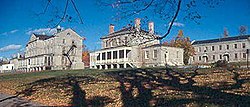Kennebec Arsenal
|
Kennebec Arsenal
|
|

Kennebec Arsenal
|
|
| Location | Augusta, Maine |
|---|---|
| Coordinates | 44°18′30″N 69°46′10″W / 44.30833°N 69.76944°WCoordinates: 44°18′30″N 69°46′10″W / 44.30833°N 69.76944°W |
| NRHP reference # | 70000046 |
| Significant dates | |
| Added to NRHP | August 25, 1970 |
| Designated NHLD | February 16, 2000 |
Kennebec Arsenal is a historic arsenal on Arsenal Street in Augusta, Maine. Largely developed between 1828 and 1838 in part because of border disputes with neighboring New Brunswick, it was designated a National Historic Landmark District in 2000 as a good example of a nearly intact early 19th-century munitions storage facility. The arsenal property was garrisoned until 1901, after which it was turned over to the State of Maine as an expansion of the adjacent Maine State Hospital. The state for many years housed mental health patients there.
The events of the War of 1812 highlighted the needs of the United States to better defend its coast against potential foreign attacks, so the federal government embarked on a large-scale development of coastal and border fortifications. Maine in particular was singled out, having had some of its communities occupied during the war, along with an ongoing border dispute with neighboring New Brunswick over the northeastern border. Tensions surrounding that border area (now roughly Aroostook County, Maine and Madawaska County, New Brunswick) rose in the 1820s as both sides pressed for development of the area. As a result, the decision was made to build a major arsenal at Augusta. The site, on the east bank of the Kennebec River south of the central business district, was chosen in part for its ready access by boat. Plans were drafted in 1827 and construction began in 1828.
Built between 1828 and 1831 were commandant's and officer quarters, barracks, stables, a carriage shop, and the main armory. Most of the major structures were built out of granite. Between 1832 and 1838 the quarters were enlarged and given their present Greek Revival styling, and the large and small magazines were built, as was a munitions laboratory. A perimeter fence of granite and iron was also added, and the building known as the Office was built, in part from the demolished remains of a stable (which was rebuilt in wood).
...
Wikipedia


